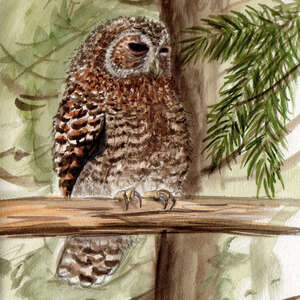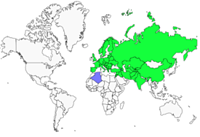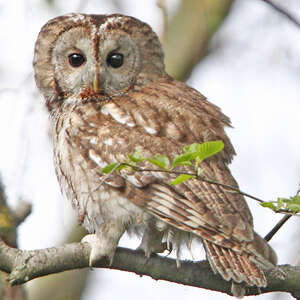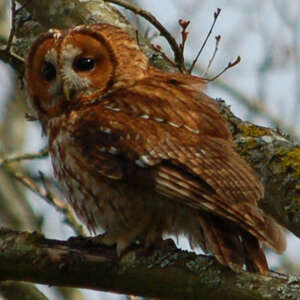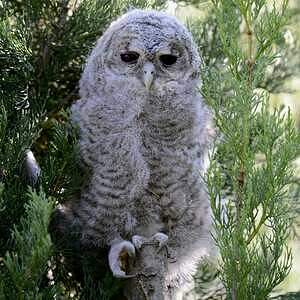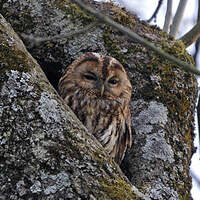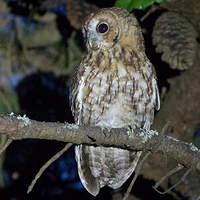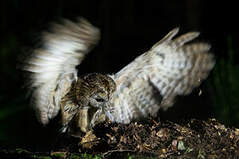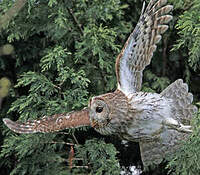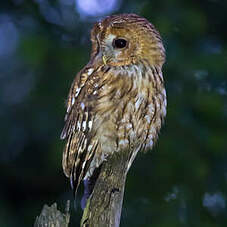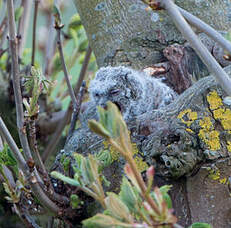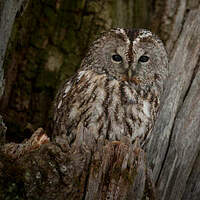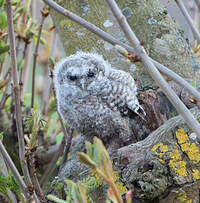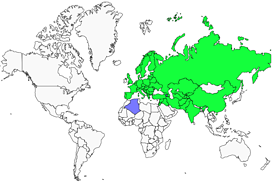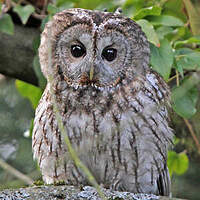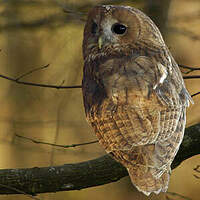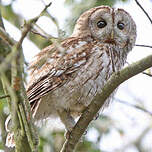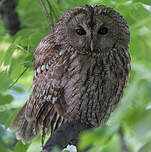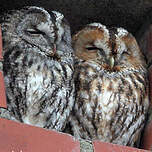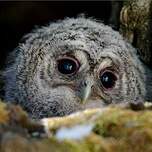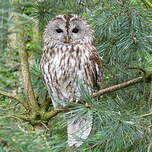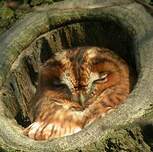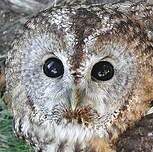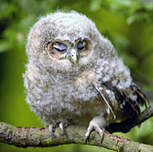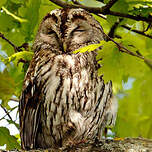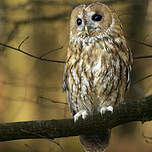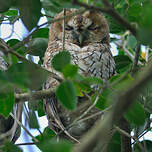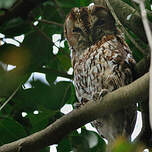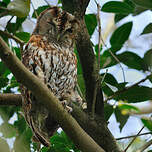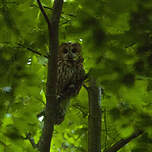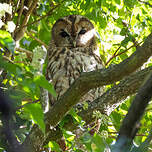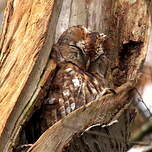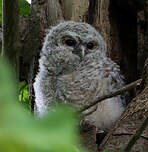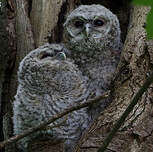Tawny Owl
Strix aluco - Chouette hulotte
Identification
The Tawny Owl is a medium-sized owl (95-105 cm wingspan) native to the Western Palearctic forest habitats. The species has two colour morphs, grey and reddish brown, like many other nocturnal raptors. The adult gray morph has a brown-gray plumage with dark and light brown spots that break the continuity and make it very cryptic. A white or cream band is particularly noticeable in the external scapulars. The underside is white to light beige, streaked and more discreetly barred with brown. The large round head has a pale facial mask with rounded contours well developed. It is cut in the centre by a dark line that joins the beak. It has faint concentric circles around the large dark eyes. The beak, topped with a white X, is straw-coloured. In the reddish morph, the cold brown-gray of the plumage is replaced by a warm reddish-brown, sometimes very vivid, to the greatest effect. But the designs remain the same. The young bird is first covered with a whitish gray down that gives way gradually to the juvenile plumage, paler, looser, more clearly and finely barred than that of the adult. The eye is very dark, with sometimes a bluish aspect in daylight.
Subspecific information 7 subspecies
- Strix aluco aluco (n, c and se Europe through the Ukraine and European Russia)
- Strix aluco biddulphi (Pakistan and nw India)
- Strix aluco harmsi (Kazakhstan, Uzbekistan and Kyrgyzstan)
- Strix aluco sanctinicolai (ne Iraq and w Iran)
- Strix aluco siberiae (Ural Mts. to w Siberia)
- Strix aluco sylvatica (w and s Europe, w Turkey)
- Strix aluco willkonskii (ne Turkey and nw Iran to Turkmenistan)
Foreign names
- Chouette hulotte,
- Cárabo común,
- coruja-do-mato-europeia,
- Waldkauz,
- macskabagoly,
- Bosuil,
- Allocco,
- kattuggla,
- Kattugle,
- sova obyčajná,
- puštík obecný,
- Natugle,
- lehtopöllö,
- gamarús euroasiàtic,
- Náttugla,
- puszczyk (zwyczajny),
- meža pūce,
- lesna sova,
- Серая неясыть,
- モリフクロウ,
- 西灰林鸮,
- 灰林鴞,
Voice song and cries
Due to its woodland habitat, it's heard more than it's seen. The male's territorial hoot gave it its vernacular name of tawny owl. It is usually emitted almost exclusively at night. It's an easy song to mimic with a human mouth and it's probably the imitation of this song used as a rallying call by smugglers-insurgents at the end of the 18th century in the west of France that earned them the name of Chouans. This song is emitted in two stages. Firstly a prolonged ouuuuu, rising then falling, followed one to two seconds later by an ou... ou ou ou ou with the first syllable detached from the following ones in a staccato. It sometimes happens that the end of the song approaches a tremolo and in this case, it may have a kinship with that of Tengmalm's Nyctale, possible source of confusion. The female responds to the male with strong disyllabic kiwits, isolated or in series. The species being common and particularly vocal, the hulotte vocalizations are part of the nocturnal soundscape of European forests. The juvenile begs with muffled tchiiits, single or doubled in tchi.iit, quite typical.
Habitat
The Tawny Owl is a bird of open and semi-open tree-filled habitats. Trees are a vital necessity for it, particularly for it's cavity nesting. The habitats it inhabits are varied, including deciduous and mixed forests, especially for the more varied physiognomically parts, parks and copses, riparian forests, rocky areas in a forested context, etc. It avoids the old compact and too uniform coppices and does not penetrate boreal coniferous forests.
Behaviour character trait
The Tawny Owl is a sedentary species which defends its territory all year round. It is quite strictly nocturnal, but its song can usually be heard during the day.
On the other hand, it only flies after nightfall. It is a very vocal bird all year round, making it easy to recognize its presence in a site. With a bit of luck, it can be observed during the day at its diurnal resting place, such as the entrance of a cavity in a tree, in a bushy bush, an imposing ivy or a rocky crevice. It is known for its aggressiveness near its nest. If approached too closely, it may attack you. It is said that a birdwatching photographer once lost an eye while trying to photograph it at its nest. Finally, due to its way of life, it rarely interferes with human activities, unlike the Scops Owl, for example.Flight
Dietfeeding habits
The Tawny Owl is a quite opportunistic predator whose diet varies according to the resources of the environment.
It experiences seasonal and inter-annual variations. Above all else, however, it is a predator of small mammals, rodents and insectivores, and small birds. Forest rodents, the Field Vole and the two different types of Moles, are systematically sampled and commonly make up more than half the biomass of the diet, especially in years of booming populations following a good fruiting of the forest species. Shrews also take up a good portion. Birds just follow after. But due to the Tawny Owl's opportunism, the diet spectrum is very wide. It includes, to a smaller degree, invertabrates (earthworms, insects...), small mollusks, amphibians like frogs and a lot of birds and mammals whose size go up to the size of the Jay and the Squirrel. Hunting is not itinerant, but the tracking down of the prey is done by ear from a well-placed perch. It has been demonstrated that males and females have slightly different feeding strategies and don't exactly hunt in the same places and after the same prey. The male tends to specialize more than the female who would have a wider spectrum. This probably serves as a way to limit the competition between them.Reproduction nesting
Tawny Owl nests in cavities, typically in old trees, but sometimes in rock crevices, rarely in an old nest of another species such as a buzzard, even more rarely in human made structures such as in unoccupied buildings or disused barns, hay or straw, in an open attic etc.
Breeding season usually runs from late February to July depending on the locality and climate. The nest is not lined or prepared in any way, the female laying three to five white, mostly round eggs, usually 2-4 days apart. The female broods for 28-30 days and is fed by the male. The chicks are brooded for 15 days before being left alone while the adults hunt. The young leave the nest after 5-6 weeks, still begging noisily, and they do not become truly independent until 2 and a half months later. The majority of them will not reach their first birthday.Geographic range
The Tawny Owl can be found throughout Europe, with the exception of Ireland and much of northern Scandinavia, where it is replaced by other species. It is not a bird of the taiga. Its distribution range extends eastward into Russian Siberia as far as the Omsk region. Further south, it can be found in the Maghreb, Anatolia and the Near East. Eastward, it becomes a mountain bird, occupying the Caucasus Mountains, the mountains of Iran and Central Asia, the Tien Shan, the Pamir, and finally the uplands straddling the extreme northeast of Afghanistan, northern Pakistan and extreme northwest India. Seven subspecies share this space. The species is strictly sedentary.
Threats - protection
Sources of information
- IOC World Bird List (v14.1), Gill, F and D Donsker (Eds). 2023.
- Les rapaces diurnes et nocturnes d'Europe, M. Cuisin, P. Geroudet
- Owls of the world, Claus KÖNIG
- Avibase, Lepage Denis
- Birds of the World, The Cornell Lab of Ornithology
- xeno-canto, Sharing bird sounds from around the world,
Other sources of interest
 Specification sheet created on
08/07/2023 by Jean François
Specification sheet created on
08/07/2023 by Jean FrançoisTranslation by AI Oiseaux.net
published: 24-05-2020 - Updated: 26-05-2020
© 1996-2024 Oiseaux.net
- Accipitriformes
- Aegotheliformes
- Anseriformes
- Apodiformes
- Apterygiformes
- Bucerotiformes
- Caprimulgiformes
- Cariamiformes
- Casuariiformes
- Charadriiformes
- Ciconiiformes
- Coliiformes
- Columbiformes
- Coraciiformes
- Cuculiformes
- Eurypygiformes
- Falconiformes
- Galliformes
- Gaviiformes
- Gruiformes
- Leptosomiformes
- Mesitornithiformes
- Musophagiformes
- Nyctibiiformes
- Opisthocomiformes
- Otidiformes
- Passeriformes
- Pelecaniformes
- Phaethontiformes
- Phoenicopteriformes
- Piciformes
- Podargiformes
- Podicipediformes
- Procellariiformes
- Psittaciformes
- Pterocliformes
- Rheiformes
- Sphenisciformes
- Steatornithiformes
- Strigiformes
- Struthioniformes
- Suliformes
- Tinamiformes
- Trogoniformes

